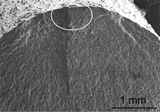Crossref Citations
This article has been cited by the following publications. This list is generated based on data provided by
Crossref.
Sun, Kaiqiang
Gao, Hong
Hu, Jiaqi
and
Yan, Yingzhu
2021.
Effect of pH on the corrosion and crack growth behavior of the ZK60 magnesium alloy.
Corrosion Science,
Vol. 179,
Issue. ,
p.
109135.
Shen, Yongshui
Sun, Tongjin
Zhu, Tao
and
Xiong, Ying
2022.
Corrosive-wear behavior of LSP/MAO treated magnesium alloys in physiological environment with three pH values.
Corrosion Reviews,
Vol. 40,
Issue. 1,
p.
65.
Li, Jinrong
Zhang, Ruiyong
Sand, Wolfgang
Zhu, Qingjun
Liu, Xin
Duan, Jizhou
Hou, Baorong
and
Zhang, Jie
2022.
Corrosion Behavior of AZ31B Magnesium Alloy Anode by Sulfate-Reducing Prokaryotes in the Tidal Flat Mud with Different Water Contents.
Lubricants,
Vol. 10,
Issue. 11,
p.
293.
Reza Kashyzadeh, Kazem
Amiri, Nima
Maleki, Erfan
and
Unal, Okan
2023.
A Critical Review on Improving the Fatigue Life and Corrosion Properties of Magnesium Alloys via the Technique of Adding Different Elements.
Journal of Marine Science and Engineering,
Vol. 11,
Issue. 3,
p.
527.
He, Meifeng
Chen, Lvxin
Yin, Meng
Xu, Shengxiao
and
Liang, Zhenyu
2023.
Review on magnesium and magnesium-based alloys as biomaterials for bone immobilization.
Journal of Materials Research and Technology,
Vol. 23,
Issue. ,
p.
4396.
Shamsi, M.
and
Sedighi, M.
2023.
Corrosion fatigue behaviour of electrospun PCL/HA coated magnesium biocomposites.
Surface Engineering,
Vol. 39,
Issue. 5,
p.
541.
Li, Xinhong
Guo, Mengmeng
and
Chen, Guoming
2023.
A hybrid algorithm for inspection planning of subsea pipelines subject to corrosion-fatigue degradation.
Process Safety and Environmental Protection,
Vol. 178,
Issue. ,
p.
685.
He, Yuantai
Wu, Liang
Yao, Wenhui
Yuan, Yuan
Wu, Rongqian
Wu, Guozhi
Wang, Jingfeng
and
Pan, Fusheng
2024.
Analysis of the evolution process of corrosion products of pure magnesium based on the phase angle.
Corrosion Science,
Vol. 240,
Issue. ,
p.
112492.
Akimov, K. O.
Ivanov, K. V.
and
Figurko, M. G.
2024.
Influence of Low-Energy High-Current Electron Beam Exposure on the Phase Composition and Corrosion Resistance of the AM60 Magnesium Alloy.
Physics of Metals and Metallography,
Vol. 125,
Issue. 3,
p.
324.
Akimov, K. O.
Ivanov, K. V.
and
Figurko, M. G.
2024.
Influence of Low-Energy High-Current Electron Beam Exposure on the Phase Composition and Corrosion Resistance of the AM60 Magnesium Alloy.
Fizika metallov i metallovedenie,
Vol. 125,
Issue. 3,
p.
356.
Putra, Reza
Hafli, Teuku
Muhammad
and
Islami, Nurul
2024.
Proceedings of the 4th International Conference on Experimental and Computational Mechanics in Engineering.
p.
581.
Nachtsheim, Julia
Ma, Songyun
Burja, Jaka
Kopp, Alexander
Seitz, Jan-Marten
and
Markert, Bernd
2024.
In vitro corrosion-fatigue behaviour of rare-earth containing magnesium WE43 in sterile complex cell culture medium.
International Journal of Fatigue,
Vol. 188,
Issue. ,
p.
108531.
He, Yuantai
Wu, Liang
Xiang, Jianpeng
Wu, Tao
Yao, Wenhui
Yuan, Yuan
Andrej, Atrens
and
Pan, Fusheng
2025.
Effect of trace Ca and Y on the corrosion behavior and discharge performance of Mg In anodes for Mg-air battery.
Journal of Energy Storage,
Vol. 114,
Issue. ,
p.
115828.
Wang, Shuang
Qian, Weifeng
Xie, Tianxiang
Chen, Yongnan
and
Li, Ning
2025.
Effect of corrosion product on corrosion behavior of PEO coating based on its structure and semiconducting properties.
Corrosion Science,
Vol. 246,
Issue. ,
p.
112727.
Liu, Mengyao
Mei, Di
Zhu, Shijie
Blawert, Carsten
Zheludkevich, Mikhail L.
Guan, Shaokang
and
Lamaka, Sviatlana V.
2025.
The external stress-assisted corrosion behavior of Mg alloys for biomedical applications.
Corrosion Science,
Vol. 249,
Issue. ,
p.
112856.
Chi, Jiuwei
Zhang, Hongliang
Song, Shuyu
Zhang, Weisheng
He, Xingyu
Nong, Zhisheng
Cui, Xue
Liu, Teng
and
Man, Tiannan
2025.
The Impact of Pre- and Post-Treatment Processes on Corrosion Resistance of Micro-Arc Oxidation Coatings on Mg Alloys: A Systematic Review.
Materials,
Vol. 18,
Issue. 3,
p.
723.
